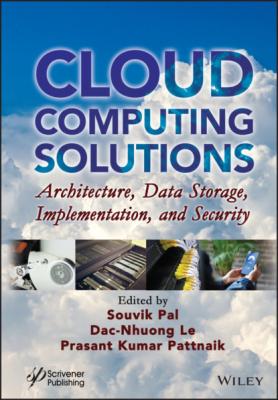Cloud Computing Solutions. Группа авторов
Читать онлайн.| Название | Cloud Computing Solutions |
|---|---|
| Автор произведения | Группа авторов |
| Жанр | Базы данных |
| Серия | |
| Издательство | Базы данных |
| Год выпуска | 0 |
| isbn | 9781119682028 |
4 4 https://cloud.google.com/appengine
5 5 https://www.eucalyptus.cloud
6 6 https://azure.microsoft.com
7 7 www.manjrasoft.com/aneka_architecture
2
INTRODUCTION TO CLOUD COMPUTING
SOUVIK PAL1, DAC-NHUONG LE2, PRASANT KUMAR PATTNAIK3
1 Sister Nivedita University, Kolkata, India
2 Haiphong University, Haiphong, Vietnam
3 KIIT, Deemed to be University, India
Email: [email protected], [email protected], [email protected]
Abstract
This chapter presents the basics of cloud computing and its related advances. Computing itself, to be considered absolutely virtualized, must give personal computers working from physically conveyed parts the ability to store and process information and program artifices. The end clients access computational and physical assets with utility computing, which portrays a business system for conveying the services and computational power upon request. Furthermore, as indicated by the need of the client, the intent of CSPs is to convey the services and cloud clients needed to pay the CSPs in view of their use. In cloud computing, clients are not required to know the basic design for getting services; they simply need to pay as per their utilization. Cloud is fundamentally a foundation which is kept up by some CSPs and end-clients are getting the services on request from the CSPs and need to pay the required cash for their utilization. Service providers like Amazon, Microsoft, Google, and IBM offer on-request resource and computational services to the client industrially.
Keywords: Cloud computing, cloud service provider
2.1 Definition of Cloud Computing
Numerous specialists from industry and scholarly circles have given numerous perspectives on cloud and its computational highlights. Some of them are given below.
Buyya et al. have stated that “Cloud is a parallel and dispensed framework consisting of a group of associated and virtualized personal computers that are progressively allocated and introduced as at least one bound together computational artifice in view of service-level agreements (SLA) built up through arrangement amongst the CSPs and shoppers.” [2].
McKinsey & Company expressed that “Clouds are hardware-based services offering compute, network and storage capacity where: 1) Hardware management is highly abstracted from the buyer. 2) Buyers incur infrastructure costs as variable OPEX. 3) Infrastructure capacity is highly elastic (up or down).” [3].
As per Vaquero et al.,: “Clouds are a large pool of easily usable and accessible virtualized resources (such as hardware, development platforms and/or services). These resources can be dynamically assigned to adjust to a variable load, allowing also for an optimum resource utilization. This pool of resources is typically exploited by a pay-per-use model in which guarantees are offered by the Infrastructure Provider by means of customized SLAs.” [4].
The National Institute of Standards and Technology (NIST)a characterizes cloud computing as “a model for enabling ubiquitous, convenient, on-demand network access to a shared pool of configurable computing resources (e.g., networks, servers, storage, applications, and services) that can be rapidly provisioned and released with minimal management effort or service provider interaction.” [5].
Armbrust et al. called cloud “datacenter hardware and software” which provide services [6]. The fundamental point of cloud computing is to consolidate the physical and computational resources and to send appropriate computational tasks to numerous dispersed personal computers.
In this digital period, customers basically prefer the pay-per-use method [7, 8].
2.2 Characteristics of Cloud
Some essential qualities of cloud computing that make it so admired are discussed below.
Figure 2.1: Characteristics of cloud.
2.2.1 Elasticity and Scalability
Cloud computing helps fulfill the dream of unending hardware and computational resources which are accessible upon request [6]. Consequently, from the user’s perspective, computational and physical resources can be maintained whenever the amount of resources are required. A cloud framework should be able to provide sufficient computational resources in a flexible manner, expanding along with the number of clients or application stacks, and can discharge the resources when its job is over.
Scalability additionally characterizes an application that is fit for scaling itself when many customers and applications are included and furthermore when the design of utilization or application necessitates changes. It ought to be equipped for discharging the resources when the clients or applications are through with the service. Scalability allows the cloud framework to scale-up and downsize as per the prerequisites of the applications.
2.2.2 Metered and Billing of Service
While utilizing cloud framework, cloud subscribers don’t need to know the fundamental engineering or the setup abilities. They don’t have to keep up the hardware and framework resources. In any case, they utilize each of those hardware or framework or calculation resources and services. Obviously, these are not free under any condition. Cloud innovation enables the clients to ask for and encourages customers to use just the required amount of resources. Services should be asked for and valued according to the appropriate premise, such as continuously or constantly, which frees up resources when their job is done [6]. Accordingly, clouds should be equipped to permit exchanging services which incorporate accounting, payment and charging services [2]. Metering ought to be classified by the type of required services, for example, processing resources, storage, appliances and framework artifices. Hence, customers need to pay according to the amount of resources and services they utilize, which is the “pay-as-you-utilize” model. In this model, the amount of resources utilized are instantly revealed by metering and charged accordingly.
2.2.3 Self-Service Allocation of Resources
Cloud users basically require the services as per their requirements. The cloud customers are essentially asking for a specific measure of services, storage, processing capacities,
